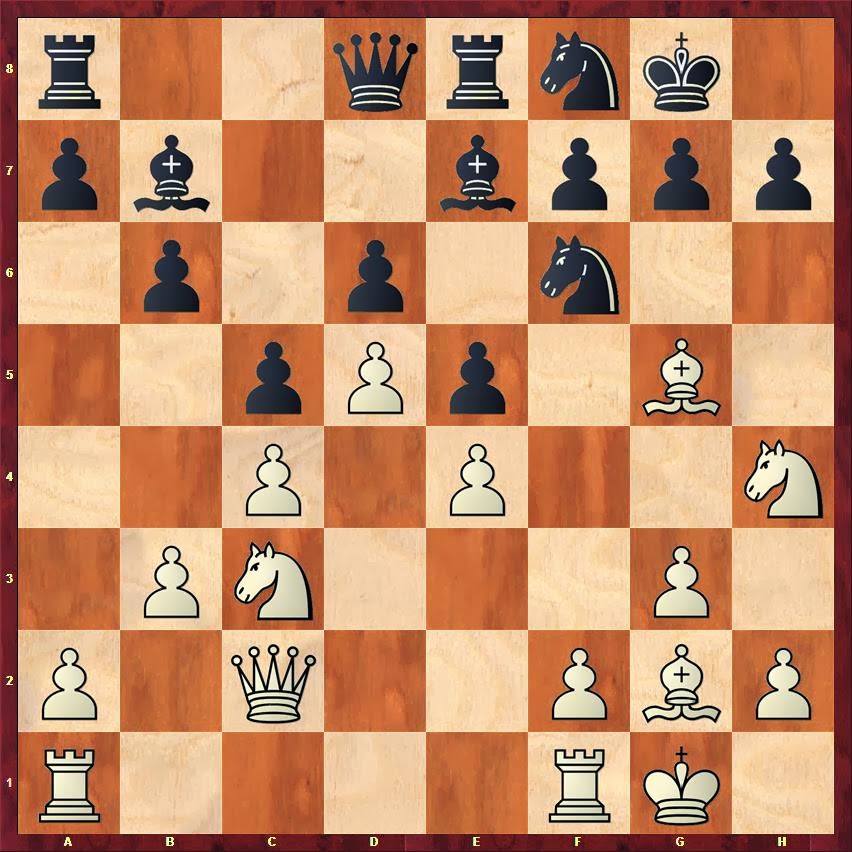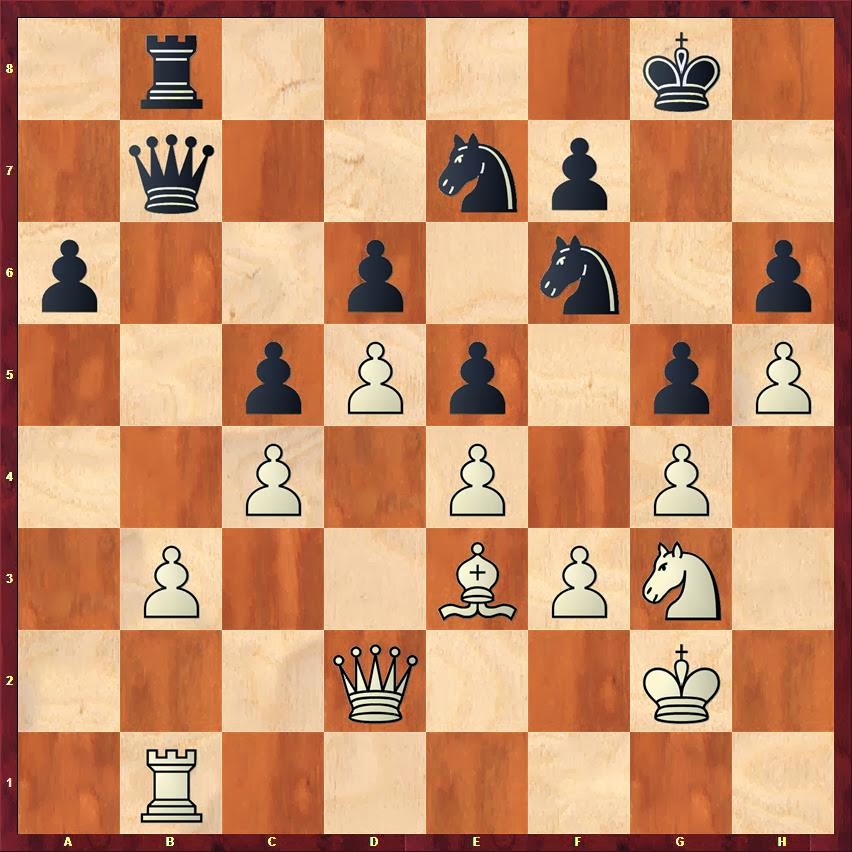David is new to the Darlington club after having some time off chess while raising his family. They say once bitten, chess is always in you and so it proved with David. His return soon proved his class, as he dispatched several top local players. Here he is in action for the North East's 4NCL first team.
David Oates V 2025 (Note this is an ELO grade, but converts to strong!)
1. c4 e5 The English. White doesn't fill the centre with pawns, but looks for a more dynamic plan. Neil Macdonald says "In the English Opening White has the freedom to embark on wing attacks that would be too risky after 1.e4 or 1.d4. There are many instances of White being able to start an enterprising attack on the kingside - often beginning with g4" in his Starting out: the English.
2.g3 After 1..e5 the opening looks like a Sicilian defense with the colours switched, a standard plan is bishop to g3 which gets called 'the reversed Dragon'.
2...Nc6 3. Bg2 g6 With g6 Black changes systems again and now we see Black setting his pieses out like a Kings Indian defence. This system was championed by the great world champion Mikhail Botvinnik
4. Nc3 Bg7 5. e4 d6
e4 blocks in the bishop on g2 which is generally bad, but in this position the idea is to dissuade Black of playing the standard King's Indian Defense plan of f5 and a king's side attack.
6. d3 Be6 Black plans to set-up a bishop and queen battery and exchange the Bishop on g2
7. Nge2 White plans a pawn break on d4, but avoids a pin.
7...Qd7 8. Nd5!
White uses tactics to disrupt Black's plan (8... Bh3 9. Bxh3 Qxh3 10. Nxc7+)
Perhaps Black could exchange the bishop for knight, but I would say White is slightly better after (8... Bxd5 9. cxd5 Nce7 10. d4) and its hard to change plans once they have begun.
8...Nce7 9. d4 c6 Black can't stand the well placed knight, but declines to swap knights with (9... Nxd5 10. cxd5 Bh3 11.
O-O) This looks ok to me, but perhaps Black thought his kinside attack was still on.
10. Ne3 Bh3 11. Bxh3 Qxh3 12. d5
White would like Black to paly (12...cxd5 13. cxd5 Nf6 (13... f5 14. Qa4+ Kf7 15. exf5 gxf5 16. Qd7) 14. Qa4+) to disrupt Black's king.
But plays 12...Qd7 I can't see anything wrong with the natural Nf6, but perhaps Black still longs for f5 and a king side attack.
13.g4 I was surprised by this move and demanded an explanation. David says, "Not
sure g4 is actually that good – just leaves opponent with decisions to make –
gives them more chance to play bad moves."
13...Bh6 14. Ng3 c5 15. h4 Bf4 16. h5 g5?! Black leaves a hole on f5 and as both of White's knights are ready to hop there this isn't a great idea for Black.
17. Nef5 No surprise! Bxg3 18. Nxg3 h6 19. Be3 Nf6 20. f3 O-O
21. Qd2 White sets up a threat in Bxg5 hxg5 and Qxg5 winning 2 pawns, so Black plays Nh7 Black is starting to look a little passive. His knight on h7 stops the trick, his other one has to guard f5, which leaves White free to tuck his king out of the way and start a queen side operation.
22.
O-O a6?! Its clear Black plans to break with b5, but White gets his break in first.
23. b4 b6 24. bxc5 bxc5 25. Qa5 Nf6
Finally Black gets his knight off the awful h7 square, but White still retains a better position as Black's knights are unable to find a role and one of them needs to guard the weak f5 square, as allowing White Nf5 would be fatal. The fight is now for the a and b files. White is better here, but not winning.
26. Kg2 Rfb8 27. Rab1 White fights for the open file, but Black has to be careful he doesn't allow his a-pawn to become too weak. 27... Qa7 28. Rb3 White will double rooks if he can
28... Rxb3 Black can't allow that, but now White will use the b-pawn as a battering ram to further weaken the Black queen side. 29. axb3 Qb7 30. Rb1 Rb8 31. Qd2 Nh7
White uses that old Bxg5 trick again! Now his pieces are ready to support the b4 break.
32. b4 a5 (32... bxa4 allows 33.c5 and if 33...dxc5 34.Bxc5 is difficult for Black as the defender of f5 is attacked by the bishop and if Nf5 is allowed Black is finished.)
33. b5 a4 Both sides have a passed pawn, but Black's a-pawn is not defended and looks weaker than White's b-pawn.
34. Qc3! White will swap the queen onto a3 to put pressure on Black's a-pawn , but also lays a fiendish plan. If (34... Ra8 35.Bxc5! dxc5 36.Qxe5 when the knight is awkward as after say a3 37.d6 leaves the knight with limited options and White has a pawn on d6 and access to f5 for his knight)
34...f6 35. Qa3
Qa7 36. b6 Rxb6 37. Rxb6 Qxb6 38. Qxa4 Kf7
Black has to be careful not to allow White's queen in with Qe8. White's queen is much more of a threat than Black's.
39. Qb5 Qxb5 Black is happy to swap queens, but now he is lost!!
40. cxb5 Ke8 41. b6
It looks as though Black's king can rush to b8 to blockade the troublesome pawn, but there is a problem
(on 41... Kd7 42. b7 Kc7 43. Bxc5! dxc5 (43... Kxb7
44. Bxd6 Ng8 45. Nf5) 44. d6+) so Black tries to use a knight to blockade instead.
41... Nf8 42. b7 Nd7 43. Bd2 The pawn and the Bishop create a 'wall' on the c-file stopping the king ever crossing onto the b-file.
43...Nb8 The knight is well placed to blockade the pawn, is it enough to draw?
44. Ba5 Kd7
With the wall blocking the Black king Black has little more than Na6-Nb8. White exploits this helplessness with
45. Kf2!! White simply plans to use his king to get access to b6. There is nothing Black can do to stop Kf2-e2-d3-c4-b5-b6
45... Na6
46.
Ke2 1-0 - Black sees the king's march and quits. Nice control and an unusual finish, although David's king march reminded me of Nigel Short's game against Timman where he used his king to march into the enemy camp. That game is copied below if your interested.
[Event "Tilburg"]
[White "Short, Nigel D"]
[Black "Timman, Jan H"]
[SourceDate "1992.02.01"]
1. e4 Nf6 2. e5 Nd5 3. d4 d6 4. Nf3 g6 5. Bc4 Nb6 6. Bb3 Bg7 7. Qe2 Nc6 8. O-O O-O 9. h3 a5 10. a4 dxe5 11. dxe5 Nd4 12. Nxd4 Qxd4 13. Re1 e6 14. Nd2 Nd5 15. Nf3 Qc5 16. Qe4 Qb4 17. Bc4 Nb6 18. b3 Nxc4 19. bxc4 Re8 20. Rd1 Qc5 21. Qh4 b6 22. Be3 Qc6 23. Bh6 Bh8 24. Rd8 Bb7 25. Rad1 Bg7 26. R8d7 Rf8 27. Bxg7 Kxg7 28.
R1d4 Rae8 29. Qf6+ Kg8 30. h4 h5 31. Kh2 Rc8 32. Kg3 Rce8 33. Kf4 Bc8 34. Kg5
1-0


















